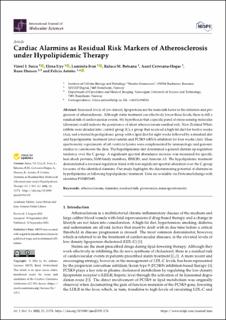| dc.contributor.author | Suica, Viorel I. | |
| dc.contributor.author | Uyy, Elena | |
| dc.contributor.author | Ivan, Luminita | |
| dc.contributor.author | Boteanu, Raluca M. | |
| dc.contributor.author | Cerveanu-Hogas, Aurel | |
| dc.contributor.author | Hansen, Rune | |
| dc.contributor.author | Antohe, Felicia | |
| dc.date.accessioned | 2023-02-23T12:39:07Z | |
| dc.date.available | 2023-02-23T12:39:07Z | |
| dc.date.created | 2022-10-28T12:29:06Z | |
| dc.date.issued | 2022 | |
| dc.identifier.citation | International Journal of Molecular Sciences. 2022, 23 (19), 11174. | en_US |
| dc.identifier.issn | 1661-6596 | |
| dc.identifier.uri | https://hdl.handle.net/11250/3053611 | |
| dc.description.abstract | Increased levels of low-density lipoproteins are the main risk factor in the initiation and progression of atherosclerosis. Although statin treatment can effectively lower these levels, there is still a residual risk of cardiovascular events. We hypothesize that a specific panel of stress-sensing molecules (alarmins) could indicate the persistence of silent atherosclerosis residual risk. New Zealand White rabbits were divided into: control group (C), a group that received a high-fat diet for twelve weeks (Au), and a treated hyperlipidemic group with a lipid diet for eight weeks followed by a standard diet and hypolipidemic treatment (atorvastatin and PCSK9 siRNA-inhibitor) for four weeks (Asi). Mass spectrometry experiments of left ventricle lysates were complemented by immunologic and genomic studies to corroborate the data. The hyperlipidemic diet determined a general alarmin up-regulation tendency over the C group. A significant spectral abundance increase was measured for specific heat shock proteins, S100 family members, HMGB1, and Annexin A1. The hypolipidemic treatment demonstrated a reversed regulation trend with non-significant spectral alteration over the C group for some of the identified alarmins. Our study highlights the discriminating potential of alarmins in hyperlipidemia or following hypolipidemic treatment. Data are available via ProteomeXchange with identifier PXD035692. | en_US |
| dc.language.iso | eng | en_US |
| dc.publisher | MDPI | en_US |
| dc.rights | Navngivelse 4.0 Internasjonal | * |
| dc.rights.uri | http://creativecommons.org/licenses/by/4.0/deed.no | * |
| dc.title | Cardiac Alarmins as Residual Risk Markers of Atherosclerosis under Hypolipidemic Therapy | en_US |
| dc.title.alternative | Cardiac Alarmins as Residual Risk Markers of Atherosclerosis under Hypolipidemic Therapy | en_US |
| dc.type | Peer reviewed | en_US |
| dc.type | Journal article | en_US |
| dc.description.version | publishedVersion | en_US |
| dc.rights.holder | © 2022 by the authors | en_US |
| dc.source.pagenumber | 16 | en_US |
| dc.source.volume | 23 | en_US |
| dc.source.journal | International Journal of Molecular Sciences | en_US |
| dc.source.issue | 19 | en_US |
| dc.identifier.doi | 10.3390/ijms231911174 | |
| dc.identifier.cristin | 2065997 | |
| dc.source.articlenumber | 11174 | en_US |
| cristin.ispublished | true | |
| cristin.fulltext | original | |
| cristin.qualitycode | 1 | |

